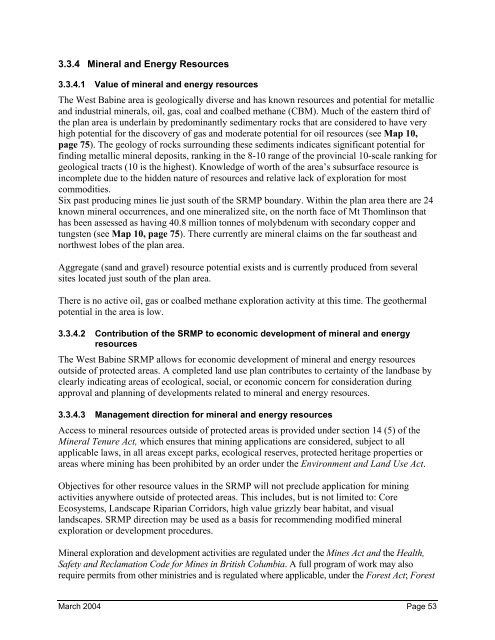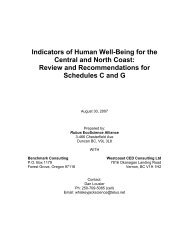West Babine Sustainable Resource Management Plan
West Babine Sustainable Resource Management Plan
West Babine Sustainable Resource Management Plan
Create successful ePaper yourself
Turn your PDF publications into a flip-book with our unique Google optimized e-Paper software.
3.3.4 Mineral and Energy <strong>Resource</strong>s<br />
3.3.4.1 Value of mineral and energy resources<br />
The <strong>West</strong> <strong>Babine</strong> area is geologically diverse and has known resources and potential for metallic<br />
and industrial minerals, oil, gas, coal and coalbed methane (CBM). Much of the eastern third of<br />
the plan area is underlain by predominantly sedimentary rocks that are considered to have very<br />
high potential for the discovery of gas and moderate potential for oil resources (see Map 10,<br />
page 75). The geology of rocks surrounding these sediments indicates significant potential for<br />
finding metallic mineral deposits, ranking in the 8-10 range of the provincial 10-scale ranking for<br />
geological tracts (10 is the highest). Knowledge of worth of the area’s subsurface resource is<br />
incomplete due to the hidden nature of resources and relative lack of exploration for most<br />
commodities.<br />
Six past producing mines lie just south of the SRMP boundary. Within the plan area there are 24<br />
known mineral occurrences, and one mineralized site, on the north face of Mt Thomlinson that<br />
has been assessed as having 40.8 million tonnes of molybdenum with secondary copper and<br />
tungsten (see Map 10, page 75). There currently are mineral claims on the far southeast and<br />
northwest lobes of the plan area.<br />
Aggregate (sand and gravel) resource potential exists and is currently produced from several<br />
sites located just south of the plan area.<br />
There is no active oil, gas or coalbed methane exploration activity at this time. The geothermal<br />
potential in the area is low.<br />
3.3.4.2 Contribution of the SRMP to economic development of mineral and energy<br />
resources<br />
The <strong>West</strong> <strong>Babine</strong> SRMP allows for economic development of mineral and energy resources<br />
outside of protected areas. A completed land use plan contributes to certainty of the landbase by<br />
clearly indicating areas of ecological, social, or economic concern for consideration during<br />
approval and planning of developments related to mineral and energy resources.<br />
3.3.4.3 <strong>Management</strong> direction for mineral and energy resources<br />
Access to mineral resources outside of protected areas is provided under section 14 (5) of the<br />
Mineral Tenure Act, which ensures that mining applications are considered, subject to all<br />
applicable laws, in all areas except parks, ecological reserves, protected heritage properties or<br />
areas where mining has been prohibited by an order under the Environment and Land Use Act.<br />
Objectives for other resource values in the SRMP will not preclude application for mining<br />
activities anywhere outside of protected areas. This includes, but is not limited to: Core<br />
Ecosystems, Landscape Riparian Corridors, high value grizzly bear habitat, and visual<br />
landscapes. SRMP direction may be used as a basis for recommending modified mineral<br />
exploration or development procedures.<br />
Mineral exploration and development activities are regulated under the Mines Act and the Health,<br />
Safety and Reclamation Code for Mines in British Columbia. A full program of work may also<br />
require permits from other ministries and is regulated where applicable, under the Forest Act; Forest<br />
March 2004 Page 53

















